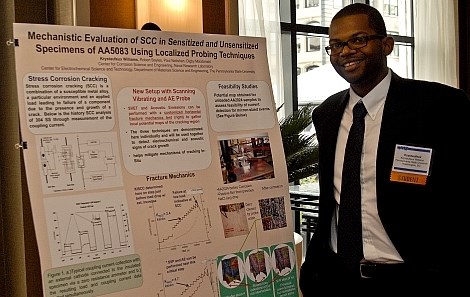AAC Student Poster Awards Announced
Reliant Aluminum Products contributes scholarships for students with winning posters; Students engaged in materials science, bioengineering, nanotechnology, electrochemical technology, corrosion science, and related engineering disciplines presented their work.

The Aluminum Anodizers Council held the second annual Student Poster Session at the 21st Annual International Anodizing Conference during Aluminum Week in Chicago, Illinois in October. Students from around the world engaged in materials science, bioengineering, nanotechnology, electrochemical technology, corrosion science, and related engineering disciplines presented their work.
Featured Content
Some of the students were on hand to present their posters to the three judges, which included AAC Chair Todd Hamilton of SAF in Atlanta, Georgia, Education Committee Chair Jude Runge, Ph.D. of Comprehensive Metallurgical Consulting in Chicago, Illinois, and Larry Chesterfield of Anodizing Technologies Inc. in Indianapolis, and a columnist for Products Finishing.
Three posters were chosen as equal winners and were each awarded with a $500 scholarship contributed by AAC member Reliant Aluminum Products LLC. One honorable mention was awarded, as well.
Anthony P. Ventura, Meghan E. Casey, and Sabrina Jedlicka of Lehigh University in Bethlehem, Pennsylvania, USA were awarded for their poster, Anodic Aluminum Oxide (AAO) Membranes for Directed Neurite Outgrowth. Their academic advisor was Professor Wojciech Z. Misiolek, Director of the Institute for Metal Forming at Lehigh University. The students focused their research on using AAO as a means to study and control neuronal growth from stem cell precursors, according to their abstract. “Activity dependent stages of neuronal growth are heavily regulated by secreted molecules. Neighboring cells can absorb these molecules making them difficult to study. The inert properties of AAO allow for the growth of neuronal cells, and the nanopores allow the [secreted proteins from the cells] to be concentrated away from neighboring cells. By selecting AAO membranes with specific nanopore size ranges, control of neuronal network density and neurite outgrowth length was achieved.”
Krystaufeux Williams from Pennsylvania State University in University Park, Pennsylvania was awarded for his poster, Mechanistic Evaluation of SCC in Sensitized and Unsensitized Specimens of AA5083 Using Localized Probing Techniques. His academic advisors were Digby MacDonald, Ph.D, Professor of Materials Science and Engineering and Director of the Center for Electrochemical Science and Technology at Penn State and Robert Bayles from the Center for Corrosion Science and Engineering, Chemistry Division, Naval Research laboratory in Washington, DC. Williams’ research focused on stress corrosion cracking (SCC) and hydrogen induced cracking (HIC) in aluminum alloys. According to the abstract, “the purpose of [the] study is to determine if the scanning vibrating/reference electrode technique (SVET/SRET/SVP) can be used to monitor the coupling current flowing through the solution. If successful, this method, which maps potential as a function of probe position, might be used to visualize and quantify the coupling current emanating from a growing stress corrosion crack in sensitized and un-sensitized aluminum alloy samples to yield more localized information about the crack growth process.”
Benjamin Mouls from Université de Toulouse in Toulouse, France was awarded for his poster, Green Processes of Etching and Anodizing of Magnesium Alloys for Aeronautical Applications. His academic advisors were Jean-Pierre Bonino and Laurent Arurault of Université de Toulouse, CIRIMAT. The poster addressed the search for an environmentally friendly anodizing process for magnesium alloys. “Nitric acid etching was extensively studied, influence of various operating parameters being clarified through a kinetic and thermodynamic study. Our study allowed predicting the etching rate and to clarify the different reactions occurring during pickling. Then and innovative anodizing process, performed in [an] acidic and environment-friendly medium, is studied,” the student noted in the abstract.
An honorable mention was awarded to Sang-yeob Sung, Mazin M. Maqableh, Anirudh Sharma and Liwen Tan of the University of Minnesota in Minneapolis, Minnesota for their poster, Fabrication of Long Range Order Periodic Nanostructures. Their academic advisor was Bethanie J. H. Stadler. Their poster outlined their research on the use of nanopore arrays, which can be used for templates in subsequent growth of nanowires with applications in magnetics, electronics, photonics, and biomedical areas.
AAC has issued the Call for Student Posters for the 2013 International Anodizing Conference and Exposition. The 22nd Annual International Anodizing Conference and Exposition is scheduled for October 1-3, 2013 at the Hyatt at Olive 8 in Seattle Washington. For more information, visit the AAC conference website at www.AACconf.org.
RELATED CONTENT
-
Fixing Corrosion Between Anodized Aluminum and Steel
Anne Deacon Juhl, Ph.D., with AluConsult, says Galvanic corrosion is due to an electrical contact with a more noble metal or a nonmetallic conductor in a conductive environment.
-
Aluminum Surface Finishing Corrosion Causes and Troubleshooting
In this paper, a review of several process solutions, examining coolants, solvent cleaning, alkaline clean/etch and deoxidizing/desmutting, listing intended and unintended chemical reactions along with possible mechanisms that would favor corrosion formation.
-
Anodizing for Bonding Applications in Aerospace
Anodizing for pre-prep bonding bridges the gap between metallic and composite worlds, as it provides a superior surface in many applications on aluminum components for bonding to these composites.


















